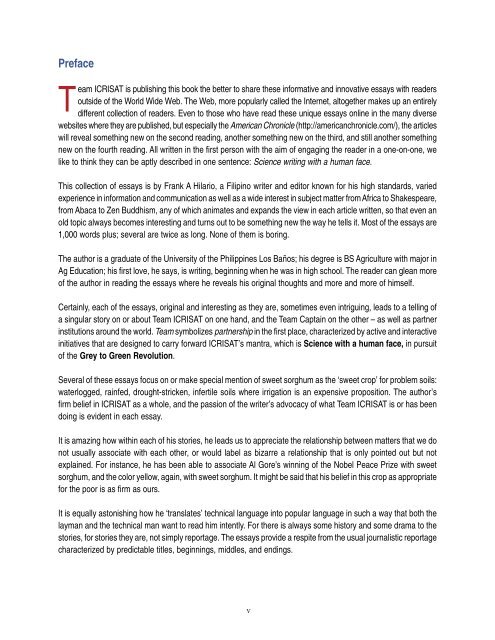Download - icrisat
Download - icrisat
Download - icrisat
You also want an ePaper? Increase the reach of your titles
YUMPU automatically turns print PDFs into web optimized ePapers that Google loves.
Preface<br />
T<br />
eam ICRISAT is publishing this book the better to share these informative and innovative essays with readers<br />
outside of the World Wide Web. The Web, more popularly called the Internet, altogether makes up an entirely<br />
different collection of readers. Even to those who have read these unique essays online in the many diverse<br />
websites where they are published, but especially the American Chronicle (http://americanchronicle.com/), the articles<br />
will reveal something new on the second reading, another something new on the third, and still another something<br />
new on the fourth reading. All written in the first person with the aim of engaging the reader in a one-on-one, we<br />
like to think they can be aptly described in one sentence: Science writing with a human face.<br />
This collection of essays is by Frank A Hilario, a Filipino writer and editor known for his high standards, varied<br />
experience in information and communication as well as a wide interest in subject matter from Africa to Shakespeare,<br />
from Abaca to Zen Buddhism, any of which animates and expands the view in each article written, so that even an<br />
old topic always becomes interesting and turns out to be something new the way he tells it. Most of the essays are<br />
1,000 words plus; several are twice as long. None of them is boring.<br />
The author is a graduate of the University of the Philippines Los Baños; his degree is BS Agriculture with major in<br />
Ag Education; his first love, he says, is writing, beginning when he was in high school. The reader can glean more<br />
of the author in reading the essays where he reveals his original thoughts and more and more of himself.<br />
Certainly, each of the essays, original and interesting as they are, sometimes even intriguing, leads to a telling of<br />
a singular story on or about Team ICRISAT on one hand, and the Team Captain on the other – as well as partner<br />
institutions around the world. Team symbolizes partnership in the first place, characterized by active and interactive<br />
initiatives that are designed to carry forward ICRISAT’s mantra, which is Science with a human face, in pursuit<br />
of the Grey to Green Revolution.<br />
Several of these essays focus on or make special mention of sweet sorghum as the ‘sweet crop’ for problem soils:<br />
waterlogged, rainfed, drought-stricken, infertile soils where irrigation is an expensive proposition. The author’s<br />
firm belief in ICRISAT as a whole, and the passion of the writer’s advocacy of what Team ICRISAT is or has been<br />
doing is evident in each essay.<br />
It is amazing how within each of his stories, he leads us to appreciate the relationship between matters that we do<br />
not usually associate with each other, or would label as bizarre a relationship that is only pointed out but not<br />
explained. For instance, he has been able to associate Al Gore’s winning of the Nobel Peace Prize with sweet<br />
sorghum, and the color yellow, again, with sweet sorghum. It might be said that his belief in this crop as appropriate<br />
for the poor is as firm as ours.<br />
It is equally astonishing how he ‘translates’ technical language into popular language in such a way that both the<br />
layman and the technical man want to read him intently. For there is always some history and some drama to the<br />
stories, for stories they are, not simply reportage. The essays provide a respite from the usual journalistic reportage<br />
characterized by predictable titles, beginnings, middles, and endings.<br />
v

















